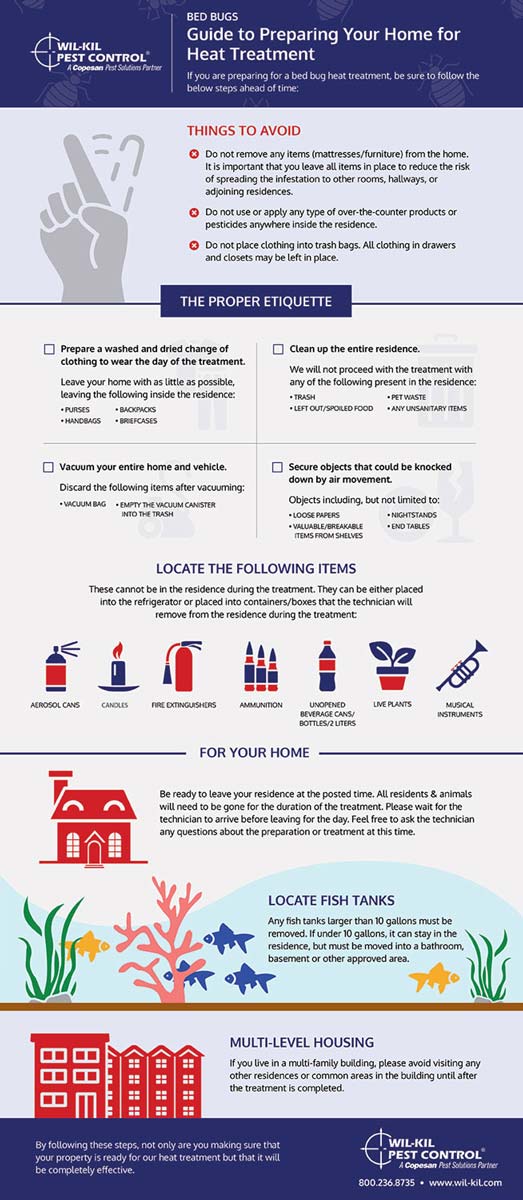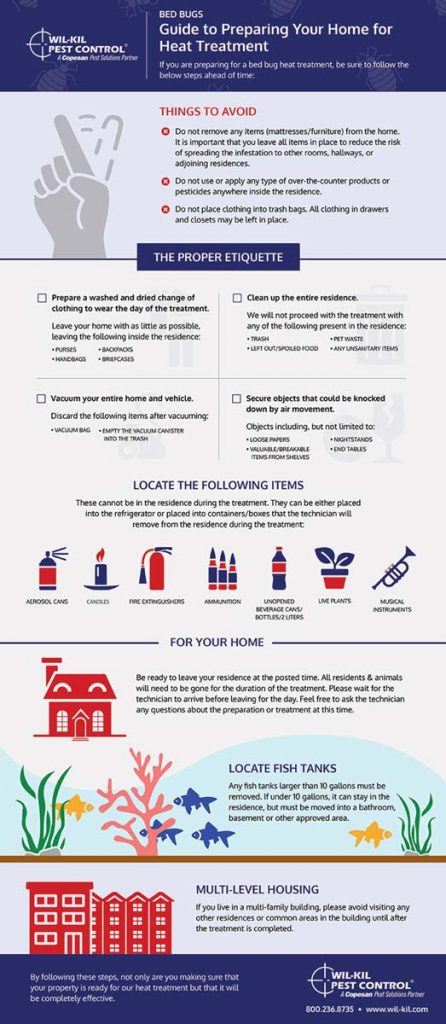If you’re looking to eliminate bed bugs for good, the best way to do it is with a heat treatment. It’s an efficient and effective way to kill the pests and their eggs, but you’re probably wondering what needs to be removed before the treatment begins. As a homeowner, it’s important to understand what items will need to be taken out of the affected area before the heat treatment can be applied. Knowing what needs to be removed can save you time and help ensure the bed bugs are eliminated for good.
What are Bed Bugs?

Bed bugs are small, flat, parasitic insects that feed on human blood. They are reddish-brown in color, wingless, and range from 1mm to 7mm (roughly the size of Lincoln’s head on a penny). They are usually found in the crevices of beds, mattresses, and headboards, as well as other furniture, behind wallpaper, and in other dark, warm areas where they can hide.
Bed bugs are most active at night, when people are sleeping and they can feed unnoticed. They feed by piercing the skin and sucking blood through two hollow tubes. After feeding, they become engorged and then crawl away to hide.
| Characteristic | Description |
|---|---|
| Size | 1mm to 7mm |
| Color | Reddish-brown |
| Wings | Wingless |
| Feeding | Piercing skin and sucking blood |
Bed bugs are not known to transmit diseases, but they can cause skin irritation, allergic reactions, and psychological distress. They can also be difficult to control and eliminate, making it important to take steps to prevent and control infestations.
What is Heat Treatment?

Heat treatment is a method of controlling bed bugs and other pests by raising the temperature in an enclosed area. This process kills the pests by exposing them to temperatures that are higher than they can survive.
- It is a non-chemical approach to pest control.
- Heat treatment involves raising the temperature of a room to a level that is lethal to bed bugs and other pests.
- It is a safe, effective, and cost-efficient way to eliminate bed bugs.
- It is used in combination with other pest control methods such as vacuuming, sealing cracks and crevices, and using insecticides.
- Heat treatment is a quick and efficient way to kill bed bugs and other pests.
Advantages and Disadvantages of Heat Treatment

Heat treatment is an effective way to get rid of bed bugs. It involves using hot air to raise the temperature of an infested area to at least 120°F. This temperature is high enough to kill the bed bugs and their eggs. While heat treatment can be effective, it has both advantages and disadvantages.
Advantages
| Advantage | Description |
|---|---|
| Eco-friendly | Heat treatment involves using hot air, so it is more eco-friendly than other methods of pest control. |
| Non-toxic | Heat treatment does not involve any toxic chemicals, making it safer for people and pets. |
| Quick | Heat treatment is a fast and effective way to get rid of bed bugs in one session. |
| Targeted | Heat treatment can be used to target specific areas, allowing you to treat only the areas that are infested. |
Disadvantages
| Disadvantage | Description |
|---|---|
| Expensive | Heat treatment can be expensive, especially if a large area needs to be treated. |
| Time-consuming | Heat treatment can be time-consuming, as it takes several hours to heat the entire area. |
| Inconvenient | Heat treatment requires furniture and items to be moved out of the area, making it inconvenient. |
| Limited reach | Heat treatment can only reach areas that hot air can reach, so it may not be effective in hard-to-reach areas. |
Heat treatment is an effective way to get rid of bed bugs, but it has its advantages and disadvantages. It is eco-friendly, non-toxic, quick, and targeted, but it can also be expensive, time-consuming, and inconvenient. Additionally, it may not be effective in hard-to-reach areas. Ultimately, it is up to you to weigh the pros and cons and decide if heat treatment is the best option for your situation.
How to Prepare for Bed Bug Heat Treatment

I need to take the necessary steps to prepare for a bed bug heat treatment. Before treatment begins I need to identify the infested area. Then I need to remove items that cannot withstand the heat of the treatment. I also need to vacuum and clean the area and finally cover and seal the area.
1. Identify the Infestation Area
The first step is to identify where the bed bugs are located. This will help me figure out where to focus my treatment efforts.
2. Remove Items That Cannot Withstand Heat
Heat treatments can get very hot, and some items cannot withstand the temperature. These items should be taken out of the area before treatment begins. This includes items like plants, electronics, and fabrics.
3. Clean and Vacuum the Area
I need to clean and vacuum the area before treatment starts. This helps remove bed bugs and eggs that may have been missed during the inspection.
4. Cover and Seal the Area
I need to cover and seal the area before treatment begins. This will help keep the heat in and prevent the bed bugs from escaping.
How to Prepare Your House for Heat Treatment
- Turn off air conditioning and fans before treatment begins.
- Gather all linens, blankets and other fabric items, as well as curtains, draperies and soft toys, and place them in bags.
- Remove items from dresser drawers and closets, and pack them in bags.
- Remove clothing from closets and place in plastic bags.
- Remove all photos, paintings, diplomas and certificates from walls.
- Remove all food items, dishes, utensils, cookware and other kitchen items, and place them in bags.
- Remove all items from drawers, shelves and cabinets.
- Empty refrigerators and freezers, and place items in bags.
- Remove all electronic items, such as computers, televisions and stereos.
- Remove all books and magazines, and store in bags.
- Remove all plants and animals.
- Once your house is empty, cover all furniture and mattresses with plastic sheets. This will help protect them from the heat.
- Close all windows and doors, and seal them with plastic sheeting.
- Make sure all vents are closed and sealed with plastic sheeting.
Potential Risks and Side Effects
Heat treatments for bed bugs carry some risks and side effects. These should be considered before deciding on a heat treatment.
| Risk/Side Effect | Description |
|---|---|
| Fire Hazard | Heat treatments can increase the risk of fires, as heating elements can become overheated and cause combustible materials to ignite. |
| Health Hazard | Excessive heat can cause respiratory issues and skin irritation. Additionally, some people may be more sensitive to the heat than others, and could experience more severe symptoms. |
| Damage to Property | Heating elements used in heat treatments can cause damage to furniture and other items in the home. |
| Inadequate Treatment | If the heat treatment is not done correctly, it may not be effective, resulting in the need for additional treatments. |
Heat treatments for bed bugs can be effective, but it is important to weigh the potential risks and side effects before deciding if heat treatment is the right option for your situation.
Frequently Asked Questions
What Needs to Be Removed for a Successful Bed Bug Heat Treatment?
Items that are capable of withstanding temperatures of at least 120°F such as electronics, books, artwork, clothes, and bedding should be removed from the treatment area to avoid damage. Furniture and other items that cannot withstand elevated temperatures should also be removed. Additionally, items that are not able to be heat treated, such as books and papers, should be vacuumed and/or sealed in plastic bags to ensure that any bed bugs present are eliminated.
How can I prepare my house for bed bug heat treatment?
Before bed bug heat treatment, it is important to prepare the house. This includes washing bedding and clothing in hot water, vacuuming frequently, removing clutter, encasing mattresses and box springs in protective covers, and sealing cracks and crevices with caulk. All items should be removed from furniture, closets, and storage areas, and placed in plastic bags to prevent the spread of bed bugs. Additionally, it is advisable to turn off air conditioners, power sources, and circuit breakers during treatment.
What steps should I take to ensure my bed bug heat treatment is successful?
Ensure all areas are treated evenly by using a thermometer to measure the temperature. Launder all clothing, linens, curtains and other fabrics in hot water and dry them on the highest heat setting for at least 20 minutes. Remove any items that cannot be laundered or heated, such as electronics, pictures and other items that will be damaged by the heat. Vacuum all furniture and carpets to remove any debris and eggs. Place all items that cannot be laundered in sealed plastic bags before the treatment. Seal any cracks or crevices to prevent the bedbugs from escaping. Ensure that all areas reach a temperature of at least 120 degrees Fahrenheit for two hours or higher for one hour. Allow the treated area to cool down before re-entering.
What items should I remove to ensure the heat treatment can reach all areas of my home?
To ensure that the heat treatment can reach all areas of your home, you should remove any items that can block the heat from reaching the intended area, such as furniture and curtains. You should also remove any items that are easily damaged by heat, such as plants, electronics, and any plastic items. Additionally, it is recommended to remove bedding, including mattresses and box springs, to ensure the heat can reach all bed bug hiding spots.
What safety measures should I take before and during the heat treatment process?
Before beginning a heat treatment, carefully remove all combustible materials, including furniture, curtains, bedding, clothing, and other items. Ensure all pilot lights, gas valves, and flammable materials are turned off. Wear protective clothing and a face mask to protect against fumes and irritants. During the heat treatment, monitor the temperature with a thermometer. Ensure that the temperature does not exceed the manufacturer’s recommended levels. Keep children and pets away from the area during the heat treatment.
Conclusion
Heat treatment is an effective way to eliminate bed bugs without the use of insecticides. However, some items may need to be removed and discarded in order to treat the bed bugs more effectively. Items such as bedding, draperies, and any items with fabric should be removed, sealed in plastic bags, and discarded. Heat treatment is most effective when the temperature is maintained at 120°F for a minimum of two hours. This is the best way to ensure that all of the bed bugs have been killed.






